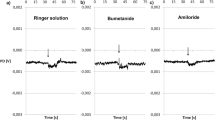Summary
Effects of changes in external ionic strength, external cation and/or anion substitution on transepithelial influx and efflux of sodium, short-circuit current and on transepithelial potential difference and resistance were studied in isolated frog skin. Active transport of Na was found to be highly dependent on both anionic and cationic composition of external medium. Relative abilities of external monovalent cations to inhibit active Na transport were H>Li>K>Rb>Cs>choline. Relative abilities of external monovalent anions to stimulate active Na transport were I>Br>Cl. Sequences of anion interaction and of resistance changes suggest that anionic stimulation of Na transport is not due to electrical coupling across outer cell membrane. The ability of different anions and cations to alter Na transport suggests that externally located charged groups act as important barriers or filters to ion movement. In addition, the experiments suggest that an increase in ionic strength of external medium has an effect on active transport of Na, a finding that indicates interference of surface charges with Na entry. Directional changes in efflux of Na due to changes in ionic composition of external medium usually paralleled changes in active Na transport. It is possible that the observed relationship between influx and efflux of Na is the result of common pathways and of interaction of the active transport system with Na efflux.
Similar content being viewed by others
References
Alvarado, R.H., Dietz, T.H., Mullen, T.L. 1975. Chloride transport across isolated skin ofRana pipiens.Am. J. Physiol. 229:869
Alvarado, R.H., Poole, A.M., Mullen, T.L. 1975, Chloride balance inRana pipiens.Am. J. Physiol. 229:861
Biber, T.U.L. 1971. Effect of changes in transepithelial transport on the uptake of sodium across the outer surface of frog skin.J. Gen. Physiol. 58:131
Biber, T.U.L., Cruz, L.J. 1973. Effect of antidiuretic hormone on sodium uptake across outer surface of the frog skin.Am. J. Physiol. 225:912
Biber, T.U.L., Curran, P.F. 1970. Direct measurements of uptake of sodium at the outer surface of the frog skin.J. Gen. Physiol. 56:83
Biber, T.U.L., Mullen, T.L. 1976. Saturation kinetics of sodium efflux across isolated frog skin.Am. J. Physiol. 231:995
Biber, T.U.L., Mullen, T.L. 1977. Effect of inhibitors on transepithelial efflux of Na and nonelectrolytes in frog skin.Am. J. Physiol. 232:C67
Biber, T.U.L., Mullen, T.L. 1979. Transition from Na transport to Cl transport after exposure of external surface of frog skin to FeCl3.Physiologist 22(4):10
Biber, T.U.L., Sanders, M.L. 1973. Influence of transepithelial potential difference on sodium uptake at the outer surface of the isolated frog skin.J. Gen. Physiol. 61:529
Boulpaep, E.L. 1976. Electrical phenomena in the nephron.Kidney Int. 9:88
Bruus, K., Kristensen, P., Larsen, E.H. 1976. Pathways for chloride and sodium transport across toad skin.Acta Physiol. Scand. 97:31
Chandler, W.K., Meves, H. 1965. Voltage clamp experiments on internally perfused giant axons.J. Physiol. (London) 180:788
Cruz, L.J., Biber, T.U.L. 1976. Transepithelial transport kinetics and Na entry in frog skin. Effects of novobiocin.Am. J. Physiol. 231:1866
DeSimone, J.A., Heck, G.L., DeSimone, S.K. 1979. A surface chemical model of salt, acid and “water” taste.In: Bioelectrochemistry: Ions, Surfaces, Membranes. M. Blank, editor. American Chemical Society Symposia Series (in press)
Eisenman, G. 1962. Cation selective glass electrodes and their mode of operation.Biophys. J. 2:259
Ferreira, K.T.G. 1968. Anionic dependence of sodium transport in the frog skin.Biochim. Biophys. Acta 150:587
Hille, B. 1975. An essential ionized acid group in sodium channels.Fed. Proc. 34:1318
Huf, E.G. 1972. The role of Cl and other anions in active Na transport in isolated frog skin.Acta Physiol. Scand. 84:366
Huf, E.G., Howell, J.R. 1974. Computer simulation of sodium fluxes in frog skin epidermis.J. Membrane Biol. 15:47
Kirschner, L.B. 1959. The interaction between sodium outflux and the sodium transport system in the frog skin.J. Cell. Comp. Physiol. 53:85
Kirschner, L.B. 1960. Permeability of frog skin to choline.Science 132:85
Kirschner, L.B. 1974. Electrolyte transport across the body surface of fresh water fish and amphibia.In: Alfred Benzon Symposium V. Transport Mechanisms in Epithelia. H.H. Ussing and N.A. Thorn, editors. Academic Press, New York
Koblick, D.C. 1959. An enzymatic ion exchange model for active sodium transport.J. Gen. Physiol. 42:635
Koefoed-Johnsen, V., Ussing, H.H. 1958. The nature of the frog skin potential.Acta Physiol. Scand. 42:298
Lindeman, B., Van Driesche, W. 1977. Sodium-specific membrane channels of frog skin are pores: Current fluctuations reveal high turnover.Science 195:292
Lindley, B.D., Hoshiko, T. 1964. The effects of alkali metal cations and common anions on the frog skin potential.J. Gen. Physiol. 47:749
Mandel, L.J., Curran, P.F. 1972. Chloride flux via a shunt pathway in frog skin: Apparent exchange diffusion.Biochim. Biophys. Acta 282:258
Mullen, T.L., Biber, T.U.L. 1978. Sodium uptake across outer surface of the frog skin.In: Membrane Transport Processes. J.F. Hoffman, editor. pp. 199–212. Raven Press, New York
Nagel, W. 1977. Influence of lithium upon the intracellular potential of frog skin epithelium.J. Membrane Biol. 37:347
Rotunno, C.A., Vilallonga, F.A., Fernandez, M., Cereijido, M. 1970. The penetration of sodium into the epithelium of the frog skin.J. Gen. Physiol. 55:716
Singer, I., Civan, M.M. 1971. Effect of anions on sodium transport in toad urinary bladder.Am. J. Physiol. 221:1019
Zeiske, W., Lindemann, B. 1975. Blockage of Na-channels in frog skin by titration with protons and by chemical modification of COO− groups.Pfluegers Arch. 355:R71
Zerahn, K. 1954. Studies on active transport of lithium in the isolated frog skin.Acta Physiol. Scand. 33:347
Author information
Authors and Affiliations
Rights and permissions
About this article
Cite this article
Biber, T.U.L., Mullen, T.L. Effect of external cation and anion substitutions on sodium transport in isolated frog skin. J. Membrain Biol. 52, 121–132 (1980). https://doi.org/10.1007/BF01869117
Issue Date:
DOI: https://doi.org/10.1007/BF01869117




